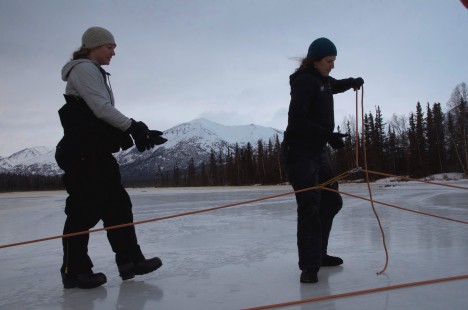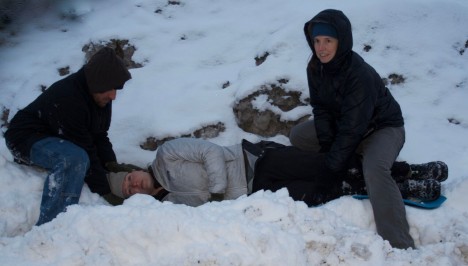
Jennifer Watts, left, learns how to rig ropes to pull a snow machine during a safety training course (Credit: Peter Griffith/NASA)
Field season is an exciting time for scientists – we leave behind the comforts of labs and offices to collect data in remote locations. Preparing for the field season is no easy task and requires an enormous amount of planning. Considerations such as “how many data loggers can I fit in my checked bag?” and “have I packed enough mosquito spray and Snickers bars?” are important parts of the equation. So is safety. In the field we are responsible for the well-being of ourselves and the team. We need to be prepared for exposure to cold weather, travel in rugged landscapes and any medical incidents that may arise.
To learn more about field safety, my colleagues and I recently traveled to southcentral Alaska for three days of wilderness first aid and snow machine safety training under the guidance of Dorothy Adler, a certified instructor with SOLO schools and the North American Outdoor Institute.

During a practice emergency situation, Watts pretends to have injuries while her colleagues diagnose her (Credit: Griffith/NASA)
Day 1: Looking at the disarray in my personal first aid kit, it was apparent that I needed professional help. Fortunately Dorothy was there with detailed advice that included an extensive list of items to add to our medical packs and how to use them. SOAP (Subjective Objective Assessment Plan) Notes, a rigorous way to document patient information, were drilled into our heads. We also practiced patient assessments and exams on paper and with partners, which included obtaining and monitoring vital signs (e.g. heart and respiratory rate), ascertaining the location and condition of injury or illness, patient treatment and emergency evacuation.
Day 2: We continued to practice our SOAP Notes while learning how to properly address conditions such as shock, musculoskeletal and soft tissue injuries, including splinting, spinal cord management, wound care and cold-related injuries. A highlight was working through “real life” outdoor emergency scenarios as a team. One of these scenarios involved multiple victims having severe injuries after falling down a mountain cliff. The rescuers were faced with assessing and treating injuries ranging from a broken tibia/fibula, a ruptured spleen and head/spinal trauma. Dealing with emergencies is never easy, but it does become more manageable with preparation and ongoing training.

Jennifer Watts pulls a snowmobile across the ice during a training exercise in Alaska (Credit: Peter Griffith/NASA)
Day 3: We ventured outside of the classroom into the beautiful Alaskan wilderness to practice cold weather travel and snow machine (also known as a “sled”) safety. At first I was nervous to be operating a powerful Polaris, but gradually became more comfortable as we experienced driving on hard-packed snow and icy trails. A practical skills course on a frozen lake had us setting up anchors with ice screws and rope systems to tow out a stuck machine (this is not trivial, as they easily weigh over 185 kg). We also practiced correct methods for side hilling, using avalanche beacons and staying warm in a cold environment. After a long but rewarding day it was time to fire up the sled and return home (safely).
Jennifer Watts is a PhD candidate at the University of Montana and researcher with the ABoVE campaign.




You have been practicing all these things to stay safe if something goes wrong, so what did it feel like when you were performing these things.